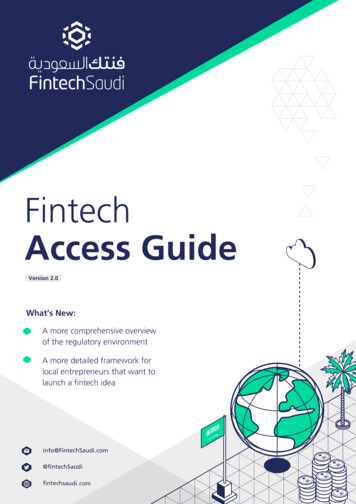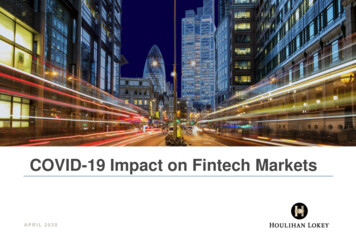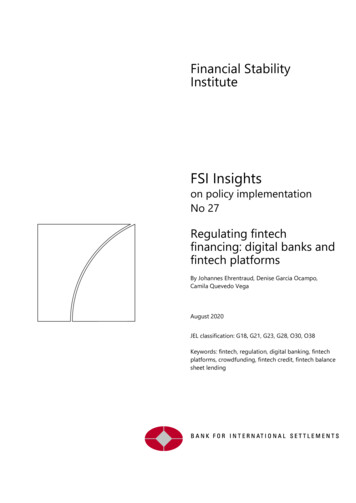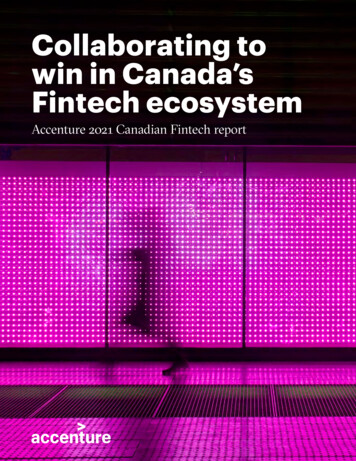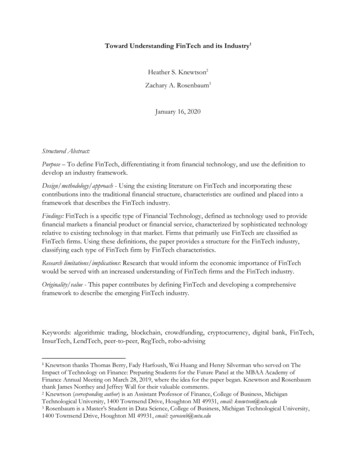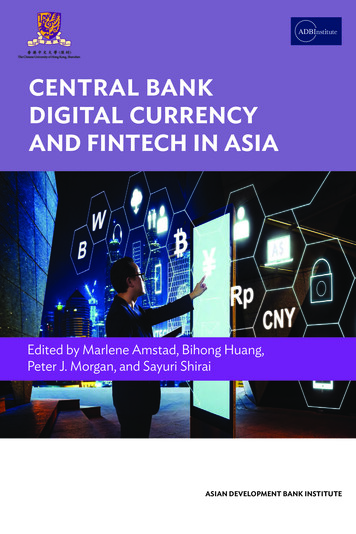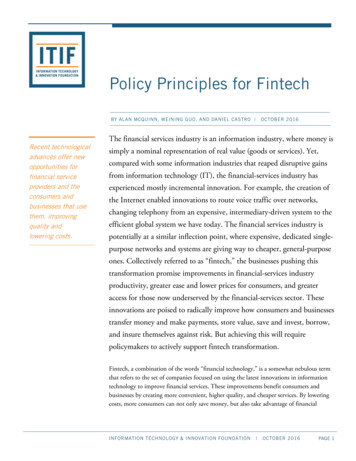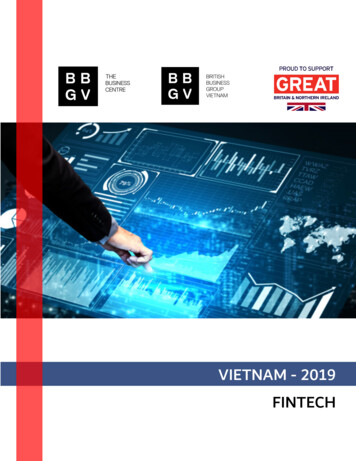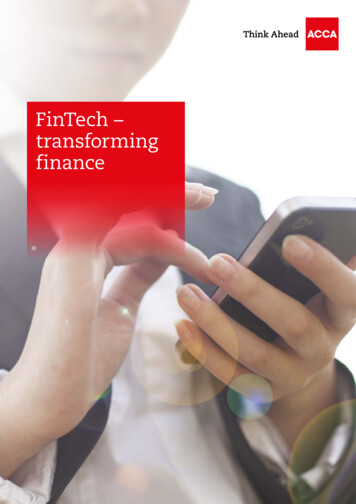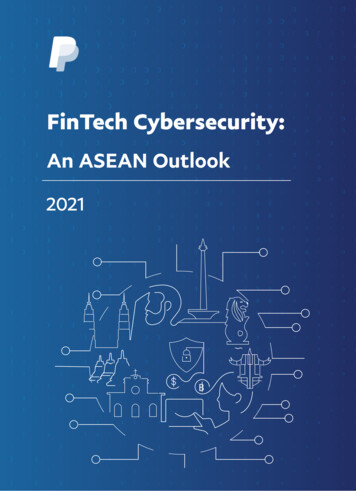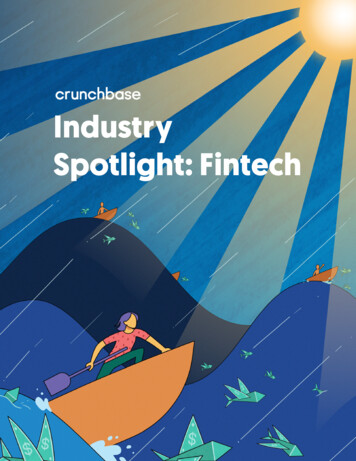
Transcription
WORLDFINTECHREPORT2020
TABLE OFCONTENTSPreface3Executive summary4Banks must board the last train to relevancy – the Open X express6BigTechs and challenger banks have opened a Pandora’s box of customerexpectations. Can banks compete?6Why collaboration counts: FinTechs’ specialized tools and expertise can empower banks7Open banking was just the beginning8The last mile is merely the visible result of customer experience212But behind the scenes, middle- and back-office operations affect customer perception12Back-end transformation can be a bumpy ride – avoid potholes with collaborationby design14FinTechs offer innovative enhancements for middle and back offices16Structure is essential for bank/FinTech partnership effectiveness19The disappointing reality of many bank/FinTech partnerships19Effective collaboration requires people, business, and process maturity – on both sides21Players that collaborate at scale to industrialize innovation will shine within theOpen X sharing economy25Appendix28Methodology32About Us34Acknowledgements35
World FinTech Report 2020PrefaceIt’s now or never.The financial services industry has been dealing with the impact of open banking since we published theinaugural World FinTech Report in 2017. Fast forward to the World FinTech Report 2020 and the imminentOpen X, a multi-sectoral open platform era maximizing the eXperience, and the harsh reality is that FinTechshave moved “from disruption to reality,” and banks that haven't embraced effective collaboration withstartups are struggling to retain and acquire new customers.Shaped by hyper-personalized service and mobile-only experience offered by unstoppable and ever-powerfulBigTechs and agile challenger banks, consumer expectations are changing in real time. To keep pace,incumbents must embrace Open X and become Inventive Banks, prepared to adopt specialized openecosystem roles and complementary support from qualified FinTech partners.No longer simply disruptors, FinTechs have matured to become respected, global players with robustacquisition rates and profitability potential. It is up to incumbents to decide whether to consider FinTechsformidable competitors or enabling allies.Most banks understand that a positive last-mile experience and an engaging front end are critical to keepingcustomers happy and loyal. However, less visible middle- and back-office operations – also essential forcustomer satisfaction – are often neglected. That’s why, despite substantial front-end investment, manybanks continue to fall short of delivering seamless and personalized customer experience.Bringing back-end operations up to speed can be an extended journey. Our World FinTech Report 2020 offersproven methods for banks to join forces with mature FinTechs to map, prioritize, and innovatively enhancetheir most-critical open platform processes.Despite synergies and the win-win potential of bank/FinTech collaboration, the frustrating reality is thatmost partnerships have not paid off. Why? Relationship stumbling blocks and differing corporate culturesprevent collaboration at scale, and innovative solutions are rarely solidified – let alone brought to market.Effective collaboration requires people, business, and process maturity from both incumbents and FinTechs.Late-stage FinTechs (scaleups) can drive productivity and value based on their last-mile expertise, datamanagement know-how, and mobile-only mentality. Inventive banks can leverage their reach, trust,and business expertise to optimize their assets and remain relevant to an increasingly diverse customer base.This is especially important given the highly uncertain economic outlook caused by never- seen-before risks.Players with readiness to collaborate at scale and industrialize innovation are the most likely to prosperwithin the shared Open X ecosystem.We encourage a focus on business outcomes to help both banks and FinTechs move from proof of conceptto the profitability of applied innovation or innovation industrialization. First movers will shape Open X roles,standards, and management.Anirban BoseVincent BastidFinancial Services Strategic Business Unit CEO& Group Executive Board Member, CapgeminiSecretary General, Efma3
Executive summaryTime’s up. To remain relevant, traditional banks must get on board with Open X. Consumers expect a lot these days as they have become accustomed to stellar service from BigTechs andchallenger banks that leverage their strength – data management – to hyper-personalize customer experience (CX). To catch up with new-age players, incumbents must embrace Open X (an open platform approach inwhich participants of all sizes and from across industries work together) and become Inventive Banks,prepared to adopt specialized roles in the new, open ecosystem – with collaborative support from qualifiedFinTech partners. FinTechs have moved from disruption to maturity to become serious, globally expanding players that areacquiring millions of customers and heading towards profitability. It’s time to consider them as tangiblecompetitors or enabling partners.Last-mile customer experience may be the visible result of Inventive Banking, butmiddle- and back-office operations are critical for CX, too. An engaging front-end requires robust and enabling back-end operations. That’s why, despite substantialfront-end investments, most banks still fail to offer seamless and personalized CX. Firms that ignore middle- and back-office innovation can impede the overall experience they offer theircustomers and in many cases their core technologies are simply unfit for this new world. Bringing middle- and back-office operations up to speed can be daunting. Banks must map and prioritizethe most critical transformational processes toward an open platform through collaboration by designwith FinTechs.4
World FinTech Report 2020Act now, act together, act at scale: Structure is essential for bank/FinTechpartnerships to work. Despite obvious synergies between banks and FinTechs, the disappointing reality is that most partnershipshave not paid off. Incumbents and FinTechs must address their relationship stumbling blocks to industrialize innovation andobtain positive return on investment. Effective collaboration requires people, business, and process maturity on both sides.–– Late-stage FinTechs (scaleups) can deliver productivity-driving value based on their last-mile expertise,data management experience, and mobile-only mentality.–– Inventive banks can leverage their reach, trust, and business expertise to optimize their assets and remainrelevant to an increasingly diverse customer base. This is especially important given the highly uncertaineconomic outlook caused by never- seen-before risks. Players that collaborate at scale to industrialize innovation will shine within the shared Open X ecosystem. A sharp focus on business outcomes will help both banks and FinTechs move from open innovation(proof of concept) to applied innovation (innovation industrialization).55
Banks must board the last train torelevancy – the Open X expressBigTechs1 and challenger banks2 haveopened a Pandora’s box of customerexpectations. Can banks compete?The gap between what customers expect and whatbanks deliver has never been wider. All customers,but in particular the Gen Y3 and younger, demand aseamless, real-time and hyper-personalized bankingexperience that complements their digital lifestyle.They expect their banks to offer an experiencethat matches the convenience of today’s popularchallenger banks. And they won’t hesitate to switchto one that offers hassle-free, relevant products andservices (Figure 1).Non-traditional firms have beentackling some of the pain pointscustomers face with incumbent banks.For instance, BigTechs and challengerbanks such as N26 offer KYC andonboarding with a fully digital andseamless customer experience; and thatis pushing banks to rethink, revamp,and reshape their customer journey.”—Laurent HerbillonDirector, Open Innovation, BNP ParibasFigure 1: Impact of BigTechs and challenger banks on the banking industryCUSTOMER PERSPECTIVEMy primary bank: has a narrow range of products and services does not exactly match my needsor preferences is not well integrated with other platforms or apps I use daily16%48%26%of overallcustomerof new-age customers*likely to switch banksin 12 monthsof new-agecustomers*Note: *denotes Gen Y and tech-savvy consumers who are part of the overall customers group.Top reasons customers adopt banking services from non-traditional players70% attracted bylow-cost offerings68% seekease of use54% wantfaster service39% pursuebetter features39% wantpersonalized productsSources: Capgemini Financial Services Analysis, 2019; World Retail Banking Report 2019 – Voice of the Customer Survey.1236BigTechs are technology giants that dominate their respective sectors, such as Amazon, Ant Financial, Apple, Facebook,Google, and Tencent. BigTech dominance is due to their understanding of the market and its needs, access to vast amountsof customer data, and delivery of delight-inducing products and services.Challenger banks are pure players with a “mobile only” designed banking experience, usually operating in multiple countries.They have their own banking license and are cloud native, operating on an open and evolutive platform. In contrast, neobanksare subsidiaries/affiliates of traditional banks (usually linked to the same core banking system) providing online/mobileexperience (with possible access to branches) while usually leveraging the same banking license.Gen Y: Customers who were born between 1983 and 2002.
World FinTech Report 20202019Capitalizing on the growing demands for improvedservices, BigTechs and challenger banks are notwasting time when it comes to expanding theirofferings and market penetration.Through an open and evolutive platform, they havestrategically evolved and scaled their financial services(FS) capabilities and now pose a tangible threat toestablished banks.A “do-what-you-do-best” approachmaximizes impact (and thereforereturns), allowing each participant tocontribute to customer experience aswell as to open ecosystem profitability.BigTechs and challenger banks are‘born digital, born data.’ They canhave a data-driven relationship,leveraging data in creative ways todrive customer insights. In contrast,traditional banks are product-driven,with data used for risk behavior only.”Many of these players broke into the market with asingle offering (often payments) and then venturedinto lending, savings, wealth management, andbeyond. Tech giants and challenger banks now offermultiple financial services and are aggressivelygrowing their presence through investment inFinTechs globally. (For additional insights, see Figure A1and A2 in Appendix).—Carlos López-MoctezumaBigTechs and challenger banks have established theirposition playing on their strengths, leveraging thewealth of data through open and evolving platformsto offer customers a convenient, personalizedexperience (Figure 2).Global Head of Open Banking, BBVAFigure 2. BigTechs and challenger banks leverage high-impact capabilitiesBuilt for mobile, deliveredonline resulting in low fixedoperating cost.New products launched withmicro-service approach bringsbusiness and technologytogether to quickly andeffectively go to market.Mobile-onlymodelAgileapproachat scaleModel built to easily plug and playnew solutions — test, improve, andscale them to continuously offerbetter services.Customer-centricdesignBigTech ainsightsOpen-platformmodelHighly intuitive approach, newways to interact in real time.Enables hyper-personalizationwith data protection.Artificial intelligence andautomation used to develop openand evolutive API-based platforms.Sources: Capgemini Financial Services Analysis, 2020; CB Insights, 2019.Why collaboration counts: FinTechs’specialized tools and expertisecan empower banksFinTechs are maturing and increasing their offerings,market presence, and customer base. The abilityto fuse innovative technology expertise with anobsessive customer focus is driving FinTech success,which enhances their attractiveness in terms ofpartnership suitability. Now more than ever,bank/FinTech collaboration is a powerful strategyto help incumbents across the business value chainfill gaps in operations, regulations, onboarding,data, technology adoption, and CX – to give today’scustomers what they demand.However, collaborating at scale will require traditionalbanks to identify and prioritize the critical customerjourneys they need to reinvent and the initiatives theyexpect to accomplish by working with FinTechs acrossopen platforms. See page 14 for more information.7
Examples of challenger banks and incumbentspartnering for profitability with FinTechs: Berlin-based challenger bank N26 began apartnership with London-based online moneytransfer service TransferWise to help N26customers save forex fees when making paymentsin foreign currencies.4 London-based Revolut collaborated withCurrencycloud (a New York-based API and serviceprovider for cross-border payments) that allowsusers to transfer currencies from all over the world.Currencycloud gives Revolut customers access tothe Currencycloud payment network via APIs thatcan integrate in two hours, without applying fornew regulatory permissions.5 Commerzbank, a major German bank, collaborateswith IDnow, a late-stage German scaleup thatuses machine-learning to verify its customers’identities via video on a smartphone or computer.The result? A 50% higher conversion rate, and 30%of Commerzbank customers verifying their identitythrough IDnow.6Open banking was just the beginningAlthough it is a transformational catalyst, openbanking is not the FS endpoint. It is a stepping stoneto free-flowing information and a sharing-economyecosystem that is beneficial to all participants as partof the impending era we call “Open X.”What is Open X?Seamless exchange ofdata and resourcesexpedited productinnovationImproved experience for customersSo, banks must evaluate where they can mostefficiently and profitably play within this open – andsharing – value-creation process. The process beginswith collaboration, but that only scratches the surfaceof the full potential of an open ecosystem. Whendata and resources are shared, the environment isripe for innovation, exponentially better productsand services, and customer experience that rivalsthe trendsetters.456788Only 6% of banks that have collaboratedwith FinTechs have achieved theirdesired and anticipated return oninvestment. What’s more, Bank/FinTechpartnerships have focused almostexclusively on front-office operations.7The fact is that banks should also deploy FinTechcapabilities across their business value chain to enableseamless data sharing from the front office to themiddle and back offices while also transforming backend operations to connect with third-party partners.Industrializing an open ecosystem means leveragingFinTech capabilities to create a streamlinedplatform system that integrates external ecosystemplayers seamlessly.There is no denying that customers want to conductfinancial transactions through high-engagementchannels such as WhatsApp, Slack, WeChat, Amazon,or whatever comes next. Therefore, banks that don’twant to become a utility provider with just data pipes(merely transferring data from one place to anotherwithout any input) must embrace platform models.8The task ahead is to create open and evolutiveplatforms that act as building blocks to produceand integrate a wide range of relevant productsand services to accommodate the fast-paced livesof today’s bank customers and their wide-rangingfinancial needs. Platformification has becomea mantra for successful businesses acrossdifferent industries.Open X ecosystem participantsleverage their key strengths.Open X leapfrogs the compliance-based approachof open banking and moves to a seamless eXchangeof data and resources empowered by an eXpeditedproduct innovation cycle that continuously improvescustomer eXperience (Figure 3).N26, “Seamless international money transfers with TransferWise,” February 29, 2016, https://n26.com/en-eu/transferwise.Currencycloud, “Building a global money app with Revolut,” April 20, w, “Case Study: y/IDnow-CaseStudy Commerzbank EN.pdf, accessed February 2020.Capgemini Retail Banking Report 2019 – Voice of the Customer Survey.Ibid.
World FinTech Report 2020Figure 3. Open X for enhanced CXg Economy arinAPShIS,InProductTraditi o n a linBankOwnershipSharedaccessOPEN XDataAssetsn, BuySource: Capgemini Financial Services Analysis, 2020.Uber is a prime example of a non-financialplayer using the full potential of the OpenX ecosystem. Uber customers experience aseamless ride-hailing service with administrativeprocesses in the background and not apparent.Uber built its flagship ride-booking offering ona partnership model with car owners, in whichUber provides a platform. It relies on GoogleMaps for its navigation and ten different paymentintegrations from credit cards to regionalpayment methods such as Paytm in India,Venmo in the US, or iDEAL in the Netherlands.9In Mexico, Uber partnered with BBVA debitcards so its driver-partners could access real-timepayments and debit card spending informationby using their smartphone app.10 With expertisefrom Visa and Barclays, Uber launched a creditcard in the US that offers Uber cash rewards thatconsumers can apply as payments in every Uberapplication.11For its food delivery offering, Uber Eats,it created a three-sided marketplacewith customers, restaurant partners, anddelivery partners.By leveraging open APIs and a collaborativeecosystem, Uber is venturing into additionalservices, including Uber Freight, Uber Works,Uber Voucher, and JUMP bikes and scooters.1112It is essential to be present in digitalecosystems like our partnership withUber–in which Uber operates in thedaily lives of our clients and potentialclients.”—Carlos López-MoctezumaGlobal Head of Open Banking, BBVAPlayers must focus on what they do best and thenposition themselves within the most beneficial Open Xecosystem role.12 Open X challenges incumbent banksto liberate themselves from long-held mindset barriersto become an Inventive Bank – agile, customercentric specialist prepared to face the new age offinancial services. Inventive bank transformationbegins with incumbents determining a strengthsbased Open X role that will generate maximum valuethrough collaboration with partners (Figure 4).Uber, “Engineering Uber’s Next-Gen Payments Platform,”December 5, A, “Uber hails BBVA as it launches Uber s-it-launchesuber-money/, accessed February 2020.9Barclays, “Uber Credit Card,” -visa-card/, accessed February 2020.The roles are specific to one business model/solution. A bank can play multiple roles at one time, but for differnt businessrequirements.9
DISTRIBUTIONExternalFigure 4. Banking evolution: from open banking integrated bank to Open X inventive bank, with role specializationInventive bankInventive bankSUPPLIERORCHESTRATORas aas anA Supplier develops products andservices delivered in white-label toa third party for distribution.Inventive bankas anAGGREGATORUniversal bankas anInternalThe traditional role of Integrator appliesto banks as “Universal bank” in fullcontrol of products and services fromdevelopment through distribution.An Orchestrator connects Aggregatorsand Suppliers and ensures theirinteractions generate maximum valuein the open marketplace.INTEGRATORInternalAn Aggregator leverages itsdistribution channels to distributeunder its brand other players’ products.PRODUCTIONExternalSource: Capgemini Financial Services Analysis, 2020.While challenger banks andBigTechs are well-positioned for theOrchestrator role, incumbents shouldchoose their role strategically.Orchestrator success will rely on a reliable coreplatform and an open infrastructure that leveragesdata effectively and integrates with other ecosystemplayers quickly and easily.Although the Orchestrator role can be lucrative,traditional banks may find it challenging to become apure-play intermediary. As we noted in the World FinTechReport 2019, pure-play orchestrators offer similarcompeting products and services (possibly includingtheir own) from several players without supplier bias.Incumbents forced to promote their products alongsidethose of competitors may face conflicts of interest orcannibalization.Although they may not be pure-play orchestratorcandidates, traditional banks can build functionalitiesto connect and coordinate products and serviceswithout cannibalizing their proprietary innovations.They can offer customers value-added services byleveraging complementary FS or non-FS solutionsfrom FinTech firms and third parties.Nevertheless, most incumbents continue to hold onto their traditional integrated role.Now is the time, however, for banks to evaluate theirstrengths and leverage their strongholds, to workwith ecosystem partners to fill developmental gaps,and to decide – strategically – which Open X role willbe the best fit. Early movers will have a decidedlycompetitive advantage.In the United States, for example, investment bankGoldman Sachs is adopting technology solutions toenable it to extend loans to small- and medium-sizedbusinesses via Amazon’s lending platform.13 And, inearly 2020, the Spanish banking group BBVA launcheda pilot plan with Amazon to sell their FS and non-FSservices. The arrangement is part of BBVA’s broaderstrategy to eventually sell digital banking products viathe GAFA giants.14Both Goldman Sachs and BBVA seek to leverageAmazon’s vast distribution network to sell products.For Amazon, banking partnerships bolster its missionto more widely profit from its enormous marketplaceand to get around some regulatory requirements.Business Insider, “What an Amazon and Goldman Sachs partnership means for Wall Street and fintechs,” February 27, 14Mobile Payments Today, “BBVA launches sales on Amazon with eye towards financial products,” January 2, al-products/.1310
World FinTech Report 2020Innovative telecom player disrupts banking throughpartnerships – Achieves success through a CX focus andan Open X orchestrator roleBusiness case: Orange, a telecom, launched amobile-only bank in France in 2017 in a bid to diversifyits portfolio in the financial services industry. Tosustain long-term growth, Orange executives soughtnew avenues of growth through vertical adjacencies toleverage the value of its telecom infrastructure. Aftera successful debut at home, Orange Bank expandedoperations to Spain in November 2019.15Implementation: Orange leveraged the expertiseof ecosystem partners to create an experience-ledmobile-only bank. Focusing on user experienceversus products, Orange collaborated withMunich-based Wirecard for contactless paymentsand the digital-first platform from Amsterdam-basedBackbase for omnichannel digital banking.16, 17Orange Bank adopted a shared-access strategy viacollaborations such as those with inWebo for identityand two-factor authentication.18Following a data-driven approach, Orange leveragesWatson (IBM’s artificial intelligence platform forbusiness) to power its Djingo chatbot, and Salesforcefor CRM to analyze customer data for providing highlycustomized services.19Tie-ups with Franfinance for consumer credit servicesand Singapore-based Moneythor for personalfinancial management offer additional examples ofOrange Bank’s partnership-led model.20, 21Results: Assuming an Open X orchestrator role,Orange Bank acts as an experience coordinatingplatform while sourcing the best services/productsfrom other relevant players.Two years after launching, Orange Bank is on its wayfrom disruption to maturity and handles 344,000accounts and has issued 122,000 loans.22Finextra, “Orange Bank launches in Spain,” November 26, nge-bank-launches-in-spain.16Wirecard, "Wirecard collaborates with Orange Money to launch innovative new digital payment and banking," May 6, -service-in-eastern-europe.17FinTech Futures, “Orange Bank goes live with Backbase banking platform,” November 13, he Paypers, “Interview with Didier Perrot, inWebo on authentication and identity management,” June 20, ntitymanagement/773635-38.19Orange, “Orange Bank brings unique customer experience with its virtual advisor powered by IBM Watson,”March 6, 2018, by-IBM-Watson.20Les Echos, “Orange bets on free services to launch its offensive in banking,” April 21, ns-la-banque-170490.21Moneythor, “Orange Bank relies on Moneythor for new digital bank,” December 5, neyworld Live, “Orange Q3 driven by growth away from home,”October 29, om-home/.1511
The last mile is merely the visible resultof customer experienceBut behind the scenes,middle- and back-office operationsaffect customer perceptionIn recent years, banks have invested heavily in IT toimprove customers’ last-mile experience. However,customers remain underwhelmed because they saybanking services have not grown to the superstarlevels they expect and receive from a few othersectors. The lack of perceivable CX improvementmay stem from banks’ bare-bones attention tomiddle- and back-office operations. And, now,these ignored behind-the-scenes processes areblunting the positive impact of front-end investmentsand collaboration (Figure 5).Figure 5: Unsupported middle-and back-office operations can freeze last-mile performanceshare of new IT investments33% (of overall IT investment) in 2019growth in IT spending4% annualby banks during 2016–2019AgileUser-friendlyAI-drivenFront-office operationsExperientialAPI-enabledMiddle-office operationsCumbersomemanual processesPoor employeeexperienceBack-office operationsLegacy systemsHigh maintenance costLow scalabilityLow share of IT budgetPersonalizedHigh share of IT budgetup from 24% in 2016Paper-baseddocumentationUNPRODUCTIVE PLATFORMIFICATIONLackluster customer satisfaction50%have not had an integratedbanking experience58%cannot access all accountsfrom a single platform60%are unable to make directbanking payments on differentplatforms (merchants)56%abandonment rate in UKbanks in 2018, up from 40% in 2016Sources23: Capgemini Financial Services Analysis 2020; World Retail Banking Report, 2019; Celent, 2019; The Financial Brand, 2019;Signicat, 2018.12
World FinTech Report 2020As data and technology proliferate, banks aretransforming their business models to keep pacewith the changing industry landscape and customerexpectations. However, continued layering ofprocesses to enable new business models ontolegacy infrastructure can hamper efforts to channelinvestments that drive end-to-end optimization.Manual, disconnected, paper-based, and siloed tasksoften weigh down these procedures, and impacts newofferings’ speed to market and customer responsetime. The result is fragmented CX.Therefore, banks must funnel resources and attentionto the middle and back offices and recalibrate thesefunctions with customers’ last-mile experience.Banks’ digital renaissance often superficially focuseson the front end. Yet, to succeed in the Open Xecosystem, banks must optimize and streamlinetheir end-to-end value chain. Based on the size andscale of operation, a bank could have more than 300 to800 middle- and back-office processes.24Without changing internal processes,problem areas will be externalized,and banks will be unable to fulfilltheir customer experience objectives.Thus, it is important to digitize internalprocesses to generate effectiveresults.”—Carlos López-MoctezumaGlobal Head of Open Banking, BBVAHow middle- and back-office functions became submerged:Complex business processesAs a result of their traditional product-centric approach, incumbentsoften layer new models on top of old, which has led tocomplicated business processes that are difficult to automate.Compliance-centric architectureIn response to regulatory demands, typical bank ITarchitecture is complex and implemented intermittently asquick fixes demand. Redesigning these ingrained systemsmay take years and cost hundreds of millions of dollars.Lack of agilityBanks struggle to find the skills needed to introduce newautomated processes. Historically, IT teams have practicedwaterfall methodologies (linear project management) thatlimit middle- and back-office process automation.Out of the (business) loopMany IT transformation teams lack visibility to bank businesspriorities. Therefore, IT project decisions are made within a siloand without thought to the full spectrum of integration options.Celent, “G
World FinTech Report 2020World FinTech Report 2019 BigTechs and challenger banks are ‘born digital, born data.’ They can have a data-driven relationship, leveraging data in creative ways to drive customer insights. In contrast, traditional banks are product-driven, with d
